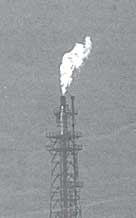Methane`s metal link
 OVERTURNING traditional theories on the natural production of methane, a major component of natural gas, a team of US researchers now says that metals such as nickel and vanadium present in the sedimentary rocks where natural gas is formed, facilitate methane formation.
OVERTURNING traditional theories on the natural production of methane, a major component of natural gas, a team of US researchers now says that metals such as nickel and vanadium present in the sedimentary rocks where natural gas is formed, facilitate methane formation.
Till recently, it was widely believed that methane was formed when organic plant matter decomposed as it was progressively buried and its temperature rose. But fresh experimental and theoretical evidence offers little support to this hypothesis.
Researchers Frank D Mango and J W Hightower at Rice University, in Texas and Alan T James at Exxon Laboratories, also in Texas, have put forward a new hypothesis to explain both the widespread occurrence of natural gas and the predominance of methane in that gas. The team proposes that the presence of metals like nickel and vanadium in the deep sedimentary rocks where natural gas and petroleum are now found, play a key role in the formation of these products from organic matter.
The researchers have found experimental evidence to support their hypothesis. They first attempted thermal decomposition of methane in the lab and found that it yielded lower methane concentrations than are ordinarily found in natural gas.
The team then heated to high temperatures rocks with a petroleum-forming potential to eliminate any organic matter and the related capacity to produce petroleum. Then these rocks, which now contained only minerals including vanadium and nickel, were heated to temperatures similar to those found when natural gas was formed in prehistory. This was done in the presence of hydrogen and organic compounds known as alkenes -- both of which in appropriate conditions are petroleum precursors.
In the latter case, Mango and his colleagues found that they were able to produce all the components of natural gas, of which methane accounted for 80 per cent. This, they say, is similar to the concentration of methane which in natural gas varies from 50 per cent to 100 per cent.
Moreover, they found that the rate at which the reaction occurred was similar to other reactions in which catalysts -- chemicals that speed up reactions, whilst remaining unchanged -- are involved.
